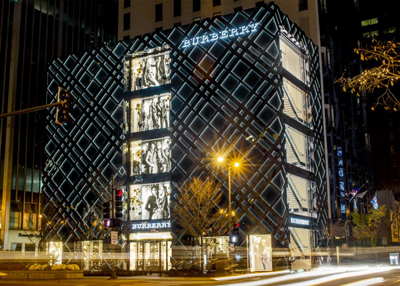Despite China’s continued position as the top spender for luxury goods, brands should consider scaling back their store footprint in the market, according to a new report from Boston Consulting Group.
In the changing luxury market, the retail expansion that drove 60 percent of the growth in previous years will be replaced by organic growth, which will now account for 70 percent of the market’s development. With consumers slowing their purchases of hard luxury in favor of experiences, BCG advises a revamped bricks-and-mortar strategy that optimizes efficiency of square footage.
"Chinese luxury consumption grew dramatically in the last decade. Now one out of three luxury items in the world is bought by a Chinese national," said Olivier Abtan, a partner and managing director in BCG’s Paris office and the global leader of the firm’s luxury topic area. "In this environment, developing presence, for example stores in China, has been key to serve Chinese consumers and grow share.
"Luxury brands who have been early in developing stores in China, have been the winners in terms of share of Chinese consumption," he said. "In 2016, we have seen consumption in mainland China grow significantly, due to foreign exchange market effects and the willingness of the government to repatriate consumption in China."
Revised strategy
BCG’s "Metroluxe: Countering Complexity in the Business of Luxury” compares its Metroluxe Index of the luxury potential in the most affluent global cities with the Bernstein Proprietary Luxury Store Count database, which uses public information to assess a brand’s number of stores in a particular city.
When compiled, these data sources reveal that many Chinese cities are oversaturated, with a store count that is not backed by their potential. With Chinese spending slowing, the firm suggests scaling back the number of stores in the country, particularly in second tier cities such as Chengdu and Tianjin.

Graph from BCG's report
In general, BCG sees opportunities for brands to adopt a more efficient store network in Asia.
On the opposite end is the United States, where the potential largely outweighs brands’ store presence. Cities such as Washington, Dallas, Chicago, Boston and even New York may still warrant more doors to cater to the local clientele.

Burberry store in Chicago
The same is true for certain European cities, including Rome and Milan.
BCG anticipates that locales that see heavy tourist traffic and strong demand from local shoppers, such as Milan, Paris, New York, Tokyo, Seoul and London will retain multiple stores for the same brand, while other markets will see their store counts reduce.
Going forward, luxury is facing a “new normal,” in which the 8-10 percent compound annual growth rate of the last 10 years makes way for a growth of only 2-5 percent per year.
Online opportunity
Retail real estate in prime areas is a significant investment (see story). BCG points out that rather than opening stores in new locales, brands will be focused on raising the efficiency of the boutiques they already have.
This may mean renegotiating a lease to reduce rent or reconfiguring the store layout. Another way to optimize for sales is to create an experience for shoppers, drawing them in-store with activities or interactive touchpoints.

Neiman Marcus' Memory Mirror
Others may choose to stay in the same city but move to a more desirable location.
Ecommerce is also making it easier for brands to either opt out of opening a store or to close an underperforming location. For instance, the U.S. may have plenty of opportunity for more luxury stores, but it may never reach the number of stores seen in other markets thanks to a strong ecommerce environment.
Across all regions, luxury ecommerce is growing at a faster rate than total sales, according to a senior analyst from Euromonitor International speaking at Luxury Interactive 2016.
Speaking on “Divergence in the Digital Landscape,” Ayako Homma noted that while the entire luxury market is expected to see a compound annual growth rate of 2 percent through 2021, luxury online sales are expected to rise at a CAGR of 7 percent in the same timeframe. To capture this growing piece of the luxury pie, brands will need to improve their omnichannel, ecommerce and mobile experiences (see story).
"In mature markets, such as selected cities in the US and Europe, there is a potential for new luxury stores," Mr. Abtan said. "Especially in tier-2 U.S. cities. Yet, development has to be thought as an omnichannel development, combining physical presence and digital/ecommerce capabilities.
"Indeed, luxury ecommerce will grow at more than 15 percent per year in the years to come," he said. "With the cost of rent increasing for top locations, the role of a physical luxury store will have to change. It must become an experience place, where brands make their clients dream and where brands convey the right luxury messages to clients while transactions will happen both online and offline."
{"ct":"eCPN\/23woQ\/\/xCpq2uImvp84CZufuKamstlv0Bv\/DFuSLb+QlL\/l5SEQCLxSGWIotFcwbiVedOO0rm6beRXhQsxe2fVvtZ0IYE7esd2ipyUoQ5aIw8+aWA524ZgXUGos43uc98U8TNpDfbrUhoNmmQNmtk0jK\/q6my6q4w+a\/oAdxjpRzDlGrF41Fus3VEemIlRMd0qGOpM7hvHFwrJI\/sYmr5AQ86KSCdQCd3A57TilsG90I1CBG4DHlhplr4Dj2FFZiHzPSHnioSVWy3Pqc3HTOa052AK1qUFw9SX2qi\/LY+hYkmNjnr2Z85FtvfsQcQW7F\/0xuqi4940IfzGwP98baCurXGO4x\/4vVpNl2o7Qs3LD\/I6a9YCWi79Jtr177sGh0aX+OKgwRd7J7bSc\/5BvNGdF53aY0GB\/nFvgsdnXfKu4s6hzn5NipbMz2StDfLLJN8mT3iAhx\/EtEBxoDfnk9htB2ehLSqKrr6NzFZdRFvQVuun\/fyFG0J+SSxTgcaAOsopWWijeRXONAxFilOGY7oSMEoNPJj8gl8j\/FekejcAKiY4MNcj76n4gvrYRcOGMRQDNnXHwTg45CKJyPotUievgA\/kMnCcI+cYBVDP+pGoolctxTyo2RR0zNkOsERhyXAQAiwjndSeKjgFVbobylJitKOhZYaENCysHDyL41A2AZRMt7a3jSDs+wno2L2MF0s1ATtTKwQJsXZpx6pzAwEPdQ1EAAf4G0FudKRMwSIJBqfRkHqh9VWIQvaefkWSrpni0X3w5UcEvCi1helPgHs+5QMrI53paEx4r57E4od5EV9xSIvLMTQsLsSbPf2kIQgDy7C4Y+QIUkLn6wHPJoqZVPSNR4AIgVTVss6uslKnm2sCSNMCyeHN9Mr+z70rfPfnytWxgMsvU94rC7A2\/X627oMaL\/UkJ03p0Vx+X8WfxOM9u\/ueLWnFlZ7aMRa8OMLzUcVmKr+YjO6ZthAa02v7CHangnPfRurackNUJ2+EeRqIyD2mZGOi6zzQDVhW9CCWGDAosrTL\/5SX0lYaglv369HuHtkbka5aKiUVmURBMBOyWv1Z29raxo5DyCeFJrPs\/H3FiOtxE5EQzVkIWuPg2U7EDn9NWtgFXRwZVRnrw1O3s6sfXt9u+maT3Umfq+u8EkzGqgqJWRbtW4n3aQTBctbkb5CVQU9zYjK1\/sZ7S87v6cJrgtqqRREgX2QNTS0oRkDm5uYlPXNBP5eF+PQ1kHYSqHRwQkhDGYq6I3JeEml1Q8aux1rmXVNXzd10PN1\/O1VsQsNHVFQXbEZE0jRodYbCG1DIeYz4AHvvRd9BagxI0tPx6PdzhfFisiOmHtSo26zQ+c\/yXQxEsnBvHZXhfnM\/mjxpyRjYGPq0SKf4uIez+dtZYdPy4t55hosT3AECIjyOfVMzQLV6gru7YjIr2IQFRgIypqiUDP1MjspgfuO0JZ8mrP645jS3Emr26n4T24JtWbkuVsnr4hnapPYcG7Jrmb133Ays4UxbxM2hE5j+fBv9AHk3nfYXn6a51E8mYcB3hMqywLYeJYrd21zo0AyNXRhi1tRoLIhD671bxpanwgzFOZ89LdtGai\/zXGqN3DtoUhyDC6Rdmwq8sO3J8b7uL0ApoNDtB9CCoRNPFeSDy\/Ryu6Re9Jds3UXb5k7b3euZlWyhRjaEBZIIjxOZSLuVTWlBBRo+MGRxc7II\/MF03sDYV6KedqP9ETjq3Xry1He+dPwzzGoy4hXK\/\/DNQ1P5h0HGB3onSFoeaoIJftiSQRBGhyJAAwqyr9nehfxPErDsaJ9QlbPF3kzuKEv54EqcJB5EIgB9COlBQVpxNzuCli7kZLV4laDB53d9q\/V1pXIaljNXkpzc7GPcp1kBbof98d3suqvXV0WV0JpED48ZtAv\/MuHe4uMTBS8ygyeNfCFG5rXBPmDPtNcs91\/fijmhsxoxQsdP1lXz4Midr2AT53nGRyGVlrmEDoIVplE\/Ts98KSTUY4vfN0Q00Vsxv1o8hLN67Fc+7R3uhD2XmcRD8vpN4r4QmKZ2tk4qEUkNE2QGSn0MPPmILZuAtj50PvUX7pURV1FVhQj1FPENao7J4lRYIi5OEhaAjNZs7I+BhHelvG4ty2HrUXtDm32jqs9hfewpxc8+\/BBDxcJM7zGIRKk+5GldDTpGMnWe0\/wwp4zekgEk\/4IaE9vEb3Izih0m9byjv86ZveRqphEoukaOBvvIkDOH0bmBl3MsefhSe99pWw0pN0CkbuUwxFCNTpgWMr2zrqp6JgDcTJmdCFc6eJ9WNzkrN7KKIo5KSlXgUDy51R\/qYTvA2kA+2aLdoAl0va+FZr+ZcCHFCULCbKqDL8qp8jbS+M2X9XZzFKXSg4hTs1VYzL580QT74+BIN4g+Vn9c\/OcTr9RNjo8+iy2An9qFsufSzfY2TdkIWpfPmRlrlJE9\/TiPg4x\/Nvb2kmFF+z\/PFR\/57xUfzr4UGV31hhytIwlfpUZSmn93rmZuqU0m7Tul2\/2KVFo4BcdnX\/qPPCjDeOD0yUedzSF\/TD4pCgQ821yO2YejGLQjyBx+WcPuzSkFESSIFv6HfRxmWNEKYdqiwALc7GNCanAAV+vtODZ\/\/Pc2iVetBi0JxhW6\/8Yi4CbDXSykYy8y4\/aqLY0i7dnJzBH946fEAynY6zDiEaS1s2jGXz6wkWsGPOaErAmW3O3aC9l6w5OGWssOojii5\/t6jvDam3zOkzZhsnFArLOlb89OaoEXwXG5PVCawHeQ1\/jqO9W15wle42nFPMW2gunRzczuyx1EgyMA6rtDnZLS1G5VGqSk2DTP9T\/\/g+2Oot\/Kq1pu2A8CKF8IXZTxhcaUiCWca\/BnwtEQRgFxgw9yhCk9QJ58x1ne5OVPAkRr43Zx6nrLxr1YOBmxvncdrqFORzFAonNIXvpSTa8dNC6q1gHJ+wFSuMoPEriI7ssXClYmHzaL05l6KYv1PstnnC1Ubgiv6+2ny5K2YOw2vxWQMmYU3i7RPpdj5dJrVT4wZNGR27KAnlgvyPZn0BDql\/3rSxb8pflXHLHGp6e6H3QPoMKHRN4fh3YkR+Z9ZmXnDrTdqIKjfM9s+o\/AQQFDr1NhPUQhniO57WTdYV2nL7Lz2yHcKBtFdAvEWN4JHe363UAg8m9GlG71voFPWhrwQuFJcVaI\/3cTnBWnrxEylF7OJkcUQo9A6aJTL3ioabcInuVevvOpdroPFUPZP38OvnUiPs\/aUSWeZrL9k0FVnOl0+MmLy7ejXduAzTCTYPepWaiNd7spQyeABlQumgwTXXznHmqhKgpBKr7R7hTfJZJr5bi2tQCZWFssKtTpUC998RnYyO4VFB2ZKDHqmUaVCavhg3hicVQkNdJuxB3qkDsteVzyuSvx2+uFTqGaSyY277\/TpIS5lNOKKu6uwI0fe2jFm6rU8lebtSMMFAeMf2BKmVl8+sFz99OnBJUHTKXpsWEco3T6jWDBN5DnhwM6Mg7KJf6DTZs7LMLydmh\/z5PjvcM+y5\/lRm7bPDbGjUdkgz8ECthCpL8Q6uaUohCPPufdwDDl+n2bMr5Dx98pijUWZATWftaR0A5eID1kt498H5iYJaBfxOYLikFCmbKQQ\/01qq8i0wGJWyfAtQUPQ1ocCG+qdwTuo2W1oFX1m3MthvqneGIDoFjOwzXq0t4UggN8hYDrtqZvPVNkdGd9pDxQDmFeT\/hNIhUwi1hia3OdweL7cV9XEimFbOYpEa\/MIb9JzICc5blIQQfB6NEFpEn92YHNs2c2bIqGoLT1S6PMGXH0pqZgWVrZF0q0VgoDG6IQ4MffXu\/c\/Cr8w1ss+JrLM\/RH2ih8HX4JXfa1r0fjxAmE+gf70CUrToeKr7wFxX1aO6gsvo7mSyV2COMbu4Mpm4DimJc\/GsLRLDp5Yh4GaUnBgjNEA+DVgxZ2vrP5QX32k5Gu8bdMOi0jBGqvDUZ7H3K6g8ETJ6JPfnXc6KwDxn4kL6R\/XJg4EjTXfWDMh735NQ8AlWt+xgfy1UGLf9isNVZVb\/pTJFXeOH5FLV0uJKO8FaeQtWlFpHTwGf6ArxdmJdwX8wkHpUu7t8n9g6lk+aHmFdhske0wfGH9gQ0IBRe43ZFgBQ6p2ZEy3RigyXdty3Ru+G7Z5w6kZwcRGDKvqXi3i5l+G9d+OcvOiBrnLOC9GI68l+lrv6CqryRBP0msi+sDXUGYzT80xHkfS7g6o3gqeETh9qqBLSjUpMgmhzyg3YXxH0HNbgMtKigY8tismrNMcJ+vnuCQ8U6QtoqrldNpdv0BVEPsIstmePYsM\/S8k56uMlUei+qXqwk3gmw79bbrdasBTL+VIupan0SKAYq1fzy68WgqE6cDPME7ljM3k6ozRiS6jHywa+tVATNYRbvep6BVOpqa6njzZX5zZt1jd3SK0TqLJp8dM+CKNXc1cAc+m+i+NCmFXo2czNwO2x+0sDi6Glb1lZYlIfB\/qKWxTH0mx7aaToRGBnEOQi39EQWhPB2cCD5DS4V7wqPUfnYdSROaDEH7BvF8glEuo0KTXFa6YWYUoOi9C37eRIXyQXJDLAbUcwdLSn7ZVqYnd8NQJO5LRXRlG9FVRnHLBpg7uImcTLg0xMSdJP8Jxv9ANl5TIfX9xHox1i1KXJWyrL9GYW7n0bv2z\/9\/ikHXxHus6jav+BCQ4pkj4\/7tiKvJOdJn6F36wqduc6cD9lQTbBPQxQwLZqEOUai9\/RQcSjOa2WTOGnHvmdja0gSlsJxA\/3o50rVZADEZenUk5IGuF30WVdcWawFSpbY38TCoRFPl+mnrZXJFBw1kFKIlLt02bQSN+eVvBwNLyY191jI+9cC\/7Mi+pYJPWoNOFTOul8R6dnfscaOX6TSx9vK95r2jG5tk8pCOnTccEBPE4Ib7kxQ39lax1+y5kj648aYQ5Nqa9qJ+dykiPyk42pBEBGUcRDwLCd0CruYhgRj+vW9yIrdxoULLIvuEMcyaIW4ffPfA5sXO3AyZBu8X3baDgni5Ye2aHcJGKA991Ejo9scstGGRfL+SZK0AfP+pbJWU42rWNkxhRk6B1llHKoYvO38mv\/bjODtZQ+3wAkuEm8q4jsVbmP7jQcoPJ3cHR67xXqGKCFqhNF0PCfvsbgYQ5vaZfAvZRwC+Pzc3ViCEAs63oNNsKFnkq7x+IeEK7g\/HarQVzRwgVGyuaAexbDaHJWXU9B2uMXt7CacVCfgV8E6E6CPKOoZKNOXzxwz7+F8D6h\/k\/4OJL0nMZLS5QP6NkL6bBrEMxx5jfVdRpcP01TUtX5cPcW1jou8GCE7l7P3XBJo4jDkEGP9Km2+ozf4aUp3iJdkaFeOWLrBLgB9adoIeI0TxtkfJmwl\/j0DeqgDYaZoahFcu4vX7l4y5JVmc2nPJ6C\/uY9ACeCjX0DFFFfDV3KXcaHDnmZPpQ50io5JxC0MUUKg3+qb76le+q0WO45uGYZaWyUIu\/0xI6dB+5eCmVqph1yvUIkEteOZDJ3ypI12U\/tPY34wQXtsF7l3tLHsFkTHQgCkPLSeYAuBwQnNPD3kdpkAQ7d4lY6CX6w7cf7uDaIAD7NHuwVbFV\/AlUnjaXJHy2CVJQaInVsOvU1Ww6fggySfTkuzUjMNcIKnXWXdPvDhEYa9Gy+BZdfznycFWfiI71o99isT3MiQOaWTPsmoHa\/5YGh5RMJ40InLHBtVvpxuJcr97xuHID7lujRNuIOxRh6ALBaWjrmLKFc6qG8EhC5p9ZG2eBhmCRFzBw+EO91dhjrJprOu3rOGocME4faKp3WpMHuk\/YOENDS0Y1ZaC7u8YmJgPgjF139pU1WsV64z+6wam2V2mV86COZXApPQuenRpZjc624YgDNbIAf2JKs1cGiwZLkXeqFj0z+fErLGUDE6\/hgMLxBvoYG039EAN3amDYWSafXeAaESqcXGKXyX5ZClzsSYJtY1XN5NoR7eHVQylHQ6LlQhH9Z5dGWLGmL68\/WLlRUMYUj6vfgXNGZvN2P0LsAqQEVm9TR0YflLGtlSkSBEAgFRg5e3S12TWnFfp\/wb4LcumQXBLRyET4\/WsFKeqN6zPqMD2Ky05aERnq1BoCbfKlP68LNPAAywOJLPHtBi51ptnHu71ce9e++HHuqUbmvIJ5WecE6S0U70qqlQjNJynD+OFr3qB\/ZcwyPOmShs1dVzeJZttAYis8NHhISxpmo3wf10Noa1WDK5vFTc01tQuGouXbgmPQH\/pe1LdQLt\/WR\/uOH8BZVCynFu\/0clDw8sTNrRkkK\/\/37fcQhHGr2s7DpVqdRCtoH+UXZxkZ1CZYio0EJ74bBYijXI4b37gx7PI601+0fzN6nynRMuQn8Ahc6FOmhTEM8MGkRcpC26Qcak+xEQBOPZ23zWF9hj20wBNjVRvOq8bxEcGU4c2OHlqHumf6YEkTXhPzuLNCRkLB6K2hiDQUyF6C5dF9EFfQ+2jBftSOKAe\/1oF8IVwEfNMw4a9HxGVEXJL8vBqxHhY0FC4tBjjz3UGzKb2tvzXzpWc6ZjXl4rEpe3BzZ+8Sa7mllOfzHTf1fAsLiT279GCTbpYHo5ColvkWHwJ67bU1Nk3GU1LDY1+0u0mF6qEwMi74E0LXkJBc5o6VjeANt7lujPkDC6uzgiIXSIeE70y287QQGALsbedLkRt9PYMSZaA1wawv8MVJ1l2NYD9D8fNq\/1yJjg7nImybulNfoQFDfERd\/mSQ5Wk8tJg+iG6mqjx8GYx1MBS8e\/U3dZzMvtX87e0y9lrPziQ2\/t1ZauKHMOgq6\/UkZxs\/nQoly\/zq7iinGiqM9Hi78E8L\/8pioBnc\/zVobIr4wqO8Tj0p6VVa+p90aoeTnXBd+a4NkpqvR9G6+BsvUHsRTsLT4U\/Rjf0yozlqAt6fevCK7xKL8CYLrKGmWRNTetv3Wpq8LWT6qhYvaDk1vBeoAv535gilixZUq8sTivWGKMPfmDO05YNi\/VEvAMUVPDo98aYort0qojJj9jkW8Z\/mmJvymc8Sr+fTUoUXnDoBPkKgsecPY+\/JLltB9iEGCQMPp5KoqV3bwMwh0+nDcSSupZGe2oQg6kfgCy4ZA8DrPNInZ1nIm3ZlrxR8HCeaCgE3zWWMYI5Jl0Y+iuJd9wFAj6mF+8MbAiD9osTVXnXi3Mn7dcUAxpElLip4lYFWOVxxxhIM9aMCRaGZjEq+va3gYA+k2dmY1TeG+SAREwLoC1agW+YVKtR\/Pe3ZrNIDDuYQT53MpMch0SZlZrzfZiDrSk+\/Ujl7FE04ovL0S1JvS6BYYrGK5HpV\/Ef2X17JT2eoYGHK5e0McXiGVFRtjz5FsuMXPJZ6a3xbQT1xf5lTO0mTP7bH3DXH6lIHIJJBxDuAlAuEu0gGFgBD4+SBlaB0O6YBzwkmJ\/+RJtmUV9h9e1GsMnkOlcEOlNBrZMHxiRljpQCYTndpLkU2\/RgwrM8pD1wVtd7hbAQeUYUYd8qgELhcPw5KwGAPdaUK+7gOyCnj1OL3cyBVLzTuJIAhi17NGgghVrCV01eGbGr77\/s35uJNcZJgw913l\/+z2nHuTbYfiSlR24UO\/ALHi+SmHYvQSG+qjwfSRnOYPVbKZLbJS+v\/OcYcjopiTEIKHS\/NlBwH2UzY+nr9rQOef58L\/y2ichkKoZ4PnmWIPiQ\/aclZuq59JX1uD5a43WK26CWjbPgO\/r1HCU8EPEd6DMyEhiZRrjzJfZJNagsb\/VGWXj3C8oD3iQleAE6VL8aWN7i7p6rTIh9cuvxr3rcMM5Q9TmBOgbGvpYIfahO6Bd+PfWKQkUsN6Eg553gZGrJ6XdrToz4zonWXDePC12I6L8GgsMOznT7tsz+dzWyVsucNDz4CJFRiVLbqHdG+afLpnFd2VAQr7JzUkFWDISvD4JG9GK957oebC0bnLXmFo7K8YpAEs7k77ASkyCBhtzqstfReEABXcQmsImq7fMBxeTCrOZLi9pPp6Oa5Hz7lw0cGOwZl99Wa5jBxDgZDCDPKFTeRjZ6\/iT3w1lQTIf\/CNf3v2gNe7UQ5CkkWuBF1sIuWXjnVb7U6LbOJzM3K761qj67AR3mlR1M08s5ul+0BRW2mAiGpUmq81kPjSSIPFFrkqyxdX5fFMaMPJt7xNvvgbaj7KZzsiJWJLkBqx8Ewcur7K1XS66nbsEeXrraK5UONF27\/j1HprR0Mj1LImA005VEp7LoOQUYm8rZL6Uqp1t3X9qQQWcj3F17rodGbJEoLVKKiJi3LyuXm8C8hh90vPdSMuM2l2CCEflSYrQzm7h8DMHo\/tbXgfnuIYtwn4nFPR6XLvAC0W7WMICxyCDOX5psK1csJ3swE\/Wt7HjPgZ9HRObpMU2h04bVFizUP4vHxwrX74UwScAhPJmpZltBwPvxNfRyRqv21kN0ASYbOXsmg77CAwZw\/\/sINeLEEXJ0W1cOi2XUR2NseZq\/T75iZttqVJIjIlmzRJ33c6JEzuDUICs5BhU1Q8y1oq4dh+NlgUs5Gm5mBXqHIjtga8NYg5cjDgrwxZvfIbDAOMm13gZYkBymuSDe3UiVIoGxz+INFvYfdyPQlEU2z+XMUs2qPVJaEkwezqpLX39Y7GGSxd5JoYYYVbTNArADhm7bduD\/PPFSIq73lk\/ZbchRk\/smYO5XzraaeJVyljFC8\/VyNHycWFSoZZuu5ft35YOzyBnaosF5v2+xhHVH4Yd9wRDSDKzIyIJxEzR9yuazA8lGjQrUA2x8d8j9YhK1hGLInIIKO4o2pUythLvzggSCKktoJ4Z00bwCXl879QY3h3oCkf3abP42BP1rKMUbWSqtGzf0G+rdM8eNCYCz0TQY2dBO7k+5JrQitjvIcdJxMwnOvNJA+QB50+9\/QgTE5o3XEOoaHrwoaknValRaKquT04sjtte8uvWFyK7jFGtkiGXTJff8YTCNLjVRDGP8nxL87y5pfRWB7H7uvp+VX4jy0bkPwL8cGQJzUf8mi+Aj8Z3F8LyHf0VFkEcmsnHZz0JYeRxaqdmun\/IQHZBg7AjBj7x2OZ0sY08fKVjx+MGptShWn3H4qx\/gaLptS0aH1ctMTX6S6YBzujB78lvCqx87Wgi5E\/uUE6QIBAws+Ecqu5FzJybUfuDBba05mxg==","iv":"55a7f120dca67525081959be6e11e2c2","s":"388e5e56abc5dd15"}

 Image courtesy of Armarium; the future of luxury retail will focus on more efficient stores
Image courtesy of Armarium; the future of luxury retail will focus on more efficient stores